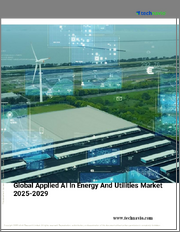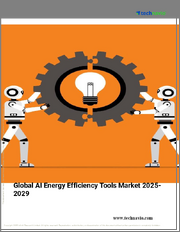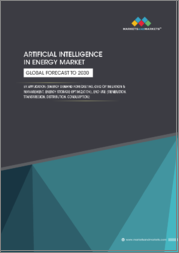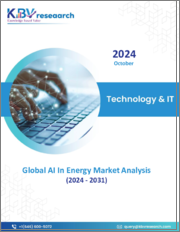
|
시장보고서
상품코드
1677288
세계의 에너지 분야 인공지능(AI) 시장 : 컴포넌트, 기술 유형, 응용 분야, 최종사용자별 - 예측(2025-2030년)Artificial Intelligence in Energy Market by Component, Technology Types, Application Areas, End User - Global Forecast 2025-2030 |
||||||
에너지 분야 인공지능(AI) 시장은 2024년 99억 2,000만 달러로 평가되었습니다. 2025년 123억 6,000만 달러에서 연평균 25.37% 성장하여 2030년에는 385억 5,000만 달러에 달할 것으로 예측됩니다.
| 주요 시장 통계 | |
|---|---|
| 기준 연도 : 2024년 | 99억 2,000만 달러 |
| 추정 연도 : 2025년 | 123억 6,000만 달러 |
| 예측 연도 : 2030년 | 385억 5,000만 달러 |
| CAGR(%) | 25.37% |
인공지능은 빠르게 에너지 환경을 재구성하고 있으며, 업무 효율성, 전략적 계획, 시스템 신뢰성 등에 큰 변화를 가져오고 있습니다. 최근 첨단 머신러닝 기술과 에너지 관리 기법의 융합은 큰 기회를 창출하고 있습니다. 에너지 기업들은 AI를 활용하여 비효율을 최소화하고, 보다 스마트한 그리드 관리와 예지보전을 통해 지속가능성을 추진하고 있습니다. 에너지 자산 전반의 디지털 전환에 대한 관심이 다시금 집중되면서 에너지 수요 및 공급 예측에 대한 강력한 분석이 가능해졌고, 사업자들은 역동적인 시장 상황에 더 잘 대응할 수 있게 됐습니다.
에너지 분야에서 AI의 중요성은 발전의 최적화에서 송전망의 건전성을 실시간으로 모니터링하는 것까지 확대되고 있습니다. 재생 가능 에너지 통합에서 기존 발전소 운영에 이르기까지 이 분야의 모든 측면이 데이터 기반 통찰력의 혜택을 누리고 있습니다. 이러한 역동적인 움직임은 성능 향상뿐만 아니라 지속가능성과 복원력을 우선시하는 새로운 비즈니스 모델로 이어지고 있습니다. 에너지 이해관계자들은 AI 솔루션에 대한 투자를 늘려 그동안 활용되지 않았던 운영 인텔리전스를 활용하고, 고급 분석을 통해 일괄적인 비용 절감과 의사결정을 강화하는 데 집중하고 있습니다.
이 보고서는 AI가 에너지 분야를 어떻게 변화시키고 있는지에 대한 종합적인 조사를 담고 있습니다. 주요 혁신, 진화하는 시장 구조, 의사결정권자가 채택할 수 있는 현실적인 전략에 대해 자세히 설명합니다. 디지털 기술이 경쟁력을 좌우하는 시대에 에너지 생산, 유통, 소비에서 AI의 역할을 이해하는 것이 가장 중요합니다. 본 보고서에서는 이러한 기술적 진보를 주도하는 주요 기업들과 함께 변혁적 변화, 세분화의 세부 사항, 지역적 격차, 그리고 주요 기업들에 대해 자세히 살펴봅니다.
에너지 정세를 재정의하는 변혁적 변화
에너지 부문은 고도의 디지털화와 인공지능의 채택 확대로 인해 전례 없는 변화를 목격하고 있으며, 기술 주도형 솔루션으로 눈에 띄게 전환하고 있습니다. 지난 10년간 전통적인 방법론은 그리드 관리를 최적화하고 에너지 저장 솔루션을 강화하는 혁신적인 예측 시스템에 점차 자리를 내주고 있습니다. 이러한 변화는 에너지 수요 증가, 환경적 제약, 재생 가능 에너지의 통합을 향한 세계 추진력 등 다양한 압력의 결과입니다.
디지털 전환은 에너지 분야에서 운영 기술과 정보 기술의 융합을 가져왔습니다. 강력한 머신러닝 모델이 최전선에 등장하여 조직이 더 높은 정확도로 소비 패턴을 예측하고, 자산 성능을 실시간으로 분석하며, 계획되지 않은 다운타임을 크게 줄일 수 있게 되었습니다. 이 시나리오에서는 사후 대응적인 솔루션에서 문제가 심각해지기 전에 문제를 예측하고 완화하는 사전 예방적 접근 방식에 초점을 맞추었습니다.
자동 제어 시스템과 스마트 센서의 도입으로 기업은 방대한 양의 데이터에서 실용적인 통찰력을 도출할 수 있게 되었습니다. 컴퓨터 비전, 자연어 처리, 로봇 공학의 통합은 일상적인 프로세스를 자동화할 뿐만 아니라 안전과 업무 효율성을 향상시켰습니다. 또한, 의사결정 과정에 최첨단 AI 기술을 도입함으로써 운영 벤치마크를 재정의하고 에너지 분배의 신뢰성과 효율성에 대한 새로운 기준을 세웠습니다. 이러한 혁신적 변화는 오늘날 투자 전략, 운영 계획, 공공 정책에 영향을 미치고 있으며, 산업 발전의 중요한 변곡점을 보여주고 있습니다.
시장 성장을 위한 주요 세분화 인사이트
시장 세분화는 에너지 분야에서 AI의 영향력을 평가할 수 있는 다양한 렌즈를 제공합니다. 구성 요소 수준에서 시장은 하드웨어, 서비스, 소프트웨어의 상호 작용을 통해 살펴볼 수 있습니다. 하드웨어 솔루션에는 고급 컨트롤러, 강력한 프로세서, 에너지 네트워크 전반의 데이터 수집을 촉진하는 복잡한 센서 어레이가 포함됩니다. 서비스 구성 요소에는 컨설팅 서비스, 구축 및 통합 전문 지식, 시스템의 원활한 운영을 보장하는 강력한 지원 및 유지보수 프레임워크가 포함됩니다. 소프트웨어 부문은 분석 솔루션과 종합적인 에너지 관리 소프트웨어로 구성되어 있으며, 현대 에너지 사업에서 데이터 분석과 민첩한 제어 메커니즘의 중요성을 강조하고 있습니다.
세분화를 더욱 세분화하기 위해서는 기술의 유형을 살펴볼 필요가 있습니다. 이 관점은 컴퓨터 비전, 머신러닝, 자연어 처리, 로봇 공학 및 기타 특수 응용 분야에 초점을 맞추었습니다. 컴퓨터 비전 분야에서는 이미지 인식 및 비디오 분석 능력이 감시 및 자산 추적을 강화하는 원동력이 됩니다. 머신러닝은 강화학습, 지도학습, 비지도학습으로 세분화됩니다. 이러한 연구 방법은 예측 분석과 적응형 시스템 응답을 강화합니다. 마찬가지로, 자연어 처리는 언어 번역과 고급 음성 인식에 이르기까지 제어실에서 휴먼-머신 인터페이스를 강화하는 데 기여합니다.
응용 분야별로 시장을 세분화하면 더 깊은 통찰력을 얻을 수 있습니다. 여기에는 수요측 관리, 에너지 관리, 그리드 관리, 예지보전과 같은 중요한 영역이 포함됩니다. 수요측 관리에서는 수요 예측과 에너지 효율 최적화와 같은 요소가 매우 중요하다는 것을 알 수 있습니다. 에너지 관리는 수요반응, 에너지 거래, 부하 예측 전략을 통해 사업자가 변동하는 소비자 수요 및 공급의 균형을 맞출 수 있게 됨에 따라 에너지 관리는 더욱 미묘해집니다. 계통 관리에서는 계통 모니터링과 마이크로그리드 개발의 중요성이 강조되고, 예지보전에서는 다운타임을 줄이기 위한 상태 모니터링과 사전 고장 예측에 중점을 둡니다.
마지막으로, 최종 사용자별로 분석하면 시장 역학에 영향을 미치는 인구통계학적으로 다양한 수요 패턴이 드러납니다. 상업용은 오피스 빌딩과 쇼핑몰을 대상으로 하며, 산업용은 광업, 석유 및 가스 등의 분야를 대상으로 합니다. 주거용 용도는 에너지 저장 시스템의 부상과 최종 사용자가 소비를 효율적으로 관리할 수 있는 스마트 홈의 혁신에 초점을 맞추었습니다. 유틸리티 부문은 배전 시스템 운영자 및 발전회사를 조사하여 에너지 생태계 내에서의 역할을 더욱 세분화합니다. 이러한 종합적인 세분화는 AI 용도의 광범위한 스펙트럼을 이해하고 특정 시장 요구를 효과적으로 충족하는 솔루션을 조정하는 데 도움이 됩니다.
목차
제1장 서문
제2장 조사 방법
제3장 주요 요약
제4장 시장 개요
제5장 시장 인사이트
- 시장 역학
- 성장 촉진요인
- 성장 억제요인
- 기회
- 과제
- 시장 세분화 분석
- Porter's Five Forces 분석
- PESTEL 분석
- 정치
- 경제
- 사회
- 기술
- 법률
- 환경
제6장 에너지 분야 인공지능(AI) 시장 : 컴포넌트별
- 하드웨어
- 컨트롤러
- 프로세서
- 센서
- 서비스
- 컨설팅 서비스
- 전개 및 통합
- 지원 및 유지관리
- 소프트웨어
- 분석 솔루션
- 에너지 관리 소프트웨어
제7장 에너지 분야 인공지능(AI) 시장 : 기술 유형별
- 컴퓨터 비전
- 영상 인식
- 비디오 분석
- 머신러닝
- 강화 학습
- 지도 학습
- 비지도 학습
- 자연언어처리
- 언어 번역
- 음성 인식
- 로봇공학
제8장 에너지 분야 인공지능(AI) 시장 : 용도별
- 수요측 관리
- 수요 예측
- 에너지 효율 최적화
- 에너지 관리
- 수요반응
- 에너지 거래
- 부하 예측
- 그리드 관리
- 그리드 감시
- 마이크로그리드
- 예측 유지관리
- 상태 모니터링
- 고장 예측
제9장 에너지 분야 인공지능(AI) 시장 : 최종사용자별
- 상업용
- 오피스 빌딩
- 쇼핑몰
- 산업
- 광업
- 석유 및 가스
- 주택
- 에너지 저장 시스템
- 스마트홈
- 유틸리티
- 배전 사업자
- 발전 회사
제10장 아메리카의 에너지 분야 인공지능(AI) 시장
- 아르헨티나
- 브라질
- 캐나다
- 멕시코
- 미국
제11장 아시아태평양의 에너지 분야 인공지능(AI) 시장
- 호주
- 중국
- 인도
- 인도네시아
- 일본
- 말레이시아
- 필리핀
- 싱가포르
- 한국
- 대만
- 태국
- 베트남
제12장 유럽, 중동 및 아프리카의 에너지 분야 인공지능(AI) 시장
- 덴마크
- 이집트
- 핀란드
- 프랑스
- 독일
- 이스라엘
- 이탈리아
- 네덜란드
- 나이지리아
- 노르웨이
- 폴란드
- 카타르
- 러시아
- 사우디아라비아
- 남아프리카공화국
- 스페인
- 스웨덴
- 스위스
- 터키
- 아랍에미리트(UAE)
- 영국
제13장 경쟁 구도
- 시장 점유율 분석, 2024
- FPNV 포지셔닝 매트릭스, 2024
- 경쟁 시나리오 분석
- 전략 분석과 제안
기업 리스트
- ABB Ltd.
- C3.ai, Inc.
- Eaton Corporation
- ENEL Group
- Engie SA
- General Electric Company
- Google, LLC
- Grid4C
- Honeywell International Inc.
- IBM Corporation
- Microsoft Corporation
- Mitsubishi Electric Corporation
- NextEra Energy, Inc.
- Nokia Corporation
- Saudi Arabian Oil Co.
- Schneider Electric
- Siemens AG
- Uplight, Inc.
- Uptake Technologies, Inc.
- Verdigris Technologies
The Artificial Intelligence in Energy Market was valued at USD 9.92 billion in 2024 and is projected to grow to USD 12.36 billion in 2025, with a CAGR of 25.37%, reaching USD 38.55 billion by 2030.
| KEY MARKET STATISTICS | |
|---|---|
| Base Year [2024] | USD 9.92 billion |
| Estimated Year [2025] | USD 12.36 billion |
| Forecast Year [2030] | USD 38.55 billion |
| CAGR (%) | 25.37% |
Artificial Intelligence is rapidly reshaping the energy landscape, driving profound changes across operational efficiency, strategic planning, and system reliability. In recent years, the confluence of advanced machine learning techniques with energy management practices has unlocked significant opportunities. Energy companies are harnessing AI to minimize inefficiencies and drive sustainability through smarter grid management and predictive maintenance. The renewed focus on digital transformation across energy assets also promotes robust analytics in forecasting energy demand and supply, ensuring that operators can better respond to dynamic market conditions.
The growing importance of AI in energy extends from optimizing power generation to enabling real-time monitoring of grid health. Every aspect of the sector, from renewable energy integration to legacy power plant operations, benefits from data-driven insights. This dynamic has not only led to performance improvements but also to new business models that prioritize sustainability and resilience. Energy stakeholders are increasingly investing in AI solutions that unlock previously untapped reserves of operational intelligence, while advanced analytics facilitate lump-sum cost savings and enhanced decision-making.
This report provides a comprehensive exploration of how AI is transforming the energy domain. It details critical innovations, evolving market structures, and pragmatic strategies that decision-makers can adopt. In an era where digital technologies dictate competitive edge, understanding the role of AI in energy production, distribution, and consumption is paramount. The discussion below delves into transformative shifts, segmentation details, regional disparities, and the leading companies that are driving these technological advancements.
Transformative Shifts Redefining the Energy Landscape
The energy sector has witnessed unprecedented changes driven by advanced digitalization and the increasing adoption of artificial intelligence, marking a notable shift toward technology-led solutions. Over the past decade, traditional methodologies are gradually giving way to innovative predictive systems that optimize grid management and enhance energy storage solutions. This transformation is a result of multi-faceted pressures including rising energy demand, environmental constraints, and the global drive toward renewable integration.
Digital transformation has led to the convergence of operational technologies and information technologies within the energy space. Robust machine learning models are now at the forefront, empowering organizations to forecast consumption patterns with higher accuracy, conduct real-time analysis of asset performance, and significantly reduce unplanned downtime. In this scenario, the emphasis on a proactive approach has shifted the focus from reactive solutions to already foreseeing and mitigating issues before they escalate.
The implementation of automated control systems and smart sensors has allowed companies to derive actionable insights from vast amounts of data. The integration of computer vision, natural language processing, and robotics has not only automated routine processes but also improved safety and operational efficiency. Moreover, the adoption of state-of-the-art AI technologies in decision-making processes has redefined operational benchmarks and set new standards for reliability and efficiency in energy distribution. Such transformational shifts are today influencing investment strategies, operational planning, and public policy, marking a critical inflection point in the industry's evolution.
Key Segmentation Insights for Market Growth
The segmentation of the market provides diverse lenses through which the impact of AI in the energy sector can be assessed. At the component level, the market is explored through the interplay of hardware, services, and software. Hardware solutions include advanced controllers, powerful processors, and intricate sensor arrays that facilitate data capture across the energy network. Service components encompass consulting services, deployment and integration expertise, and robust support and maintenance frameworks, ensuring systems run seamlessly. Software segments stretch across analytical solutions and comprehensive energy management software, underscoring the importance of data interpretation and agile control mechanisms in modern energy operations.
Further refinement in segmentation is achieved by examining technology types. This perspective highlights specialized applications such as computer vision, machine learning, natural language processing, and robotics. Within computer vision, the capability to perform image recognition and video analysis drives enhanced surveillance and asset tracking. The machine learning subdivision is elaborated into reinforcement learning, supervised learning, and unsupervised learning; these methodologies empower predictive analytics and adaptive system responses. Similarly, natural language processing spans language translation and sophisticated speech recognition, contributing to enhanced human-machine interfaces in control rooms.
A deeper insight emerges when the market is segmented by application areas. These include critical domains like demand-side management, energy management, grid management, and predictive maintenance. Within demand-side management, factors such as demand forecasting and energy efficiency optimization emerge as pivotal. Energy management becomes more nuanced through demand response, energy trading, and load forecasting strategies that enable operators to balance supply with fluctuating consumer demand. Grid management underscores the importance of grid monitoring and the development of microgrids, while predictive maintenance focuses on condition monitoring and proactive fault prediction to reduce downtime.
Finally, an analysis segmented by end users reveals demographically diverse demand patterns that influence market dynamics. Commercial establishments are examined through the lens of office buildings and shopping malls, while industrial applications delve into sectors such as mining and oil & gas. Residential applications focus on the rise of energy storage systems and smart home innovations that allow end users to manage consumption effectively. The utilities segment further dissects roles within the energy ecosystem by exploring distribution system operators and generation companies. This comprehensive segmentation helps in understanding the broad spectrum of AI applications and tailoring solutions to meet specific market needs effectively.
Based on Component, market is studied across Hardware, Services, and Software. The Hardware is further studied across Controllers, Processors, and Sensors. The Services is further studied across Consulting Services, Deployment & Integration, and Support & Maintenance. The Software is further studied across Analytical Solutions and Energy Management Software.
Based on Technology Types, market is studied across Computer Vision, Machine Learning, Natural Language Processing, and Robotics. The Computer Vision is further studied across Image Recognition and Video Analysis. The Machine Learning is further studied across Reinforcement Learning, Supervised Learning, and Unsupervised Learning. The Natural Language Processing is further studied across Language Translation and Speech Recognition.
Based on Application Areas, market is studied across Demand-Side Management, Energy Management, Grid Management, and Predictive Maintenance. The Demand-Side Management is further studied across Demand Forecasting and Energy Efficiency Optimization. The Energy Management is further studied across Demand Response, Energy Trading, and Load Forecasting. The Grid Management is further studied across Grid Monitoring and Microgrids. The Predictive Maintenance is further studied across Condition Monitoring and Fault Prediction.
Based on End User, market is studied across Commercial, Industrial, Residential, and Utilities. The Commercial is further studied across Office Buildings and Shopping Malls. The Industrial is further studied across Mining and Oil & Gas. The Residential is further studied across Energy Storage Systems and Smart Homes. The Utilities is further studied across Distribution System Operators and Generation Companies.
Key Regional Insights Across Global Markets
Regional dynamics are an essential element in understanding the deployment of AI within the energy sector. In the Americas, progressive policy frameworks and abundant investments in renewable technologies have spurred the adoption of avant-garde digital solutions. The characteristics of mature infrastructure and strong demand-side strategies enable energy firms in this region to lead in the implementation of AI-driven management systems. The region's emphasis on integrating smart grids and optimizing energy supply chains has catalyzed numerous innovations that serve as benchmarks for global practices.
In Europe, the Middle East, and Africa, the interplay between regulatory reforms and resource diversification plays a critical role in accelerating the digital transition. This region is characterized by an evolving market environment where public-private partnerships fuel advancement, and technology adoption is often backed by governmental incentives. The diversity within this region, spanning from advanced European hubs to rapidly growing energy markets in the Middle East and Africa, marks a unique blend of legacy infrastructure and cutting-edge research in AI-enabled energy solutions.
The Asia-Pacific region stands out due to its rapid industrial expansion and significant investments in sustainable development. Here, energy consumption patterns are evolving quickly as urbanization and technological advancement drive demand for more efficient management systems. Integrated AI solutions are quickly being adopted to handle the massive influx of data generated from smart city projects and renewable integrations. The combination of cost-effective technology deployment and the drive for modernization makes the Asia-Pacific a significant contributor to innovation in the energy sector.
Based on Region, market is studied across Americas, Asia-Pacific, and Europe, Middle East & Africa. The Americas is further studied across Argentina, Brazil, Canada, Mexico, and United States. The United States is further studied across California, Florida, Illinois, New York, Ohio, Pennsylvania, and Texas. The Asia-Pacific is further studied across Australia, China, India, Indonesia, Japan, Malaysia, Philippines, Singapore, South Korea, Taiwan, Thailand, and Vietnam. The Europe, Middle East & Africa is further studied across Denmark, Egypt, Finland, France, Germany, Israel, Italy, Netherlands, Nigeria, Norway, Poland, Qatar, Russia, Saudi Arabia, South Africa, Spain, Sweden, Switzerland, Turkey, United Arab Emirates, and United Kingdom.
Key Companies Influencing the AI in Energy Landscape
Several industry players have emerged at the intersection of artificial intelligence and energy. Leaders such as ABB Ltd. and C3.ai, Inc. have been instrumental in integrating AI-driven solutions with traditional energy systems, thereby enabling significant improvements across operational pipelines and strategic planning. Eaton Corporation and ENEL Group have utilized intelligent automation to balance production efficiencies, while Engie SA and General Electric Company continue to innovate in the realm of predictive maintenance and grid management.
Giants like Google, LLC and IBM Corporation have contributed extensive technological expertise, integrating machine learning and cloud computing to enhance data processing capabilities. Grid4C and Honeywell International Inc. provide specialized services that focus on energy conservation and real-time analytics, while Microsoft Corporation and Mitsubishi Electric Corporation continually push the envelope on software-driven automation in power generation. NextEra Energy, Inc. and Nokia Corporation have positioned themselves as pioneers in employing smart technologies to balance regional power grids, and renowned enterprises such as Saudi Arabian Oil Co. and Schneider Electric are increasingly leveraging AI for greater operational efficiencies.
Furthermore, Siemens AG, Uplight, Inc., Uptake Technologies, Inc., and Verdigris Technologies continue to lead the charge by offering novel solutions that combine advanced robotics, sensor technology, and real-time analytics. Their combined efforts in driving AI adoption underscore the transformative potential of digital solutions in energy management, paving the way for smarter, more resilient infrastructure on a global scale.
The report delves into recent significant developments in the Artificial Intelligence in Energy Market, highlighting leading vendors and their innovative profiles. These include ABB Ltd., C3.ai, Inc., Eaton Corporation, ENEL Group, Engie SA, General Electric Company, Google, LLC, Grid4C, Honeywell International Inc., IBM Corporation, Microsoft Corporation, Mitsubishi Electric Corporation, NextEra Energy, Inc., Nokia Corporation, Saudi Arabian Oil Co., Schneider Electric, Siemens AG, Uplight, Inc., Uptake Technologies, Inc., and Verdigris Technologies. Actionable Recommendations for Industry Leaders to Embrace AI
Industry leaders must prioritize the integration of artificial intelligence to transform traditional energy operations into agile, data-driven networks. First, enhance operational visibility by investing in robust hardware solutions and sophisticated sensor technologies that provide real-time insights into energy flows. Implementation of advanced controller systems can optimize grid performance and minimize energy losses.
Leaders should also focus on building comprehensive ecosystems that blend hardware, services, and software. It is critical to deploy consulting services that aid in system integration, ensuring that new digital technologies are seamlessly merged with legacy systems while enhancing overall efficiency. Recognizing the value of analytical solutions and energy management software is also fundamental in deriving actionable insights that drive strategic decision-making.
Further, organizations must leverage the latest innovations in machine learning, computer vision, natural language processing, and robotics to gain a competitive edge. Adopting these technologies can lead to more accurate demand forecasting, improved grid monitoring, and enhanced predictive maintenance strategies. With the rapid evolution of digital tools, it is essential to foster a culture of continuous learning and technological agility within the organization.
Finally, industry leaders should evaluate regional market dynamics and the strengths of diverse AI technology providers to tailor localized solutions. Collaborating with technology innovators and consulting with research professionals will help identify the most effective strategies for digital transformation. These proactive measures not only lay the groundwork for sustainable growth but also facilitate a smoother transition towards a fully integrated, AI-powered energy ecosystem.
Conclusion: Embracing the Future of AI in Energy
The evolution of artificial intelligence in the energy sector represents a seismic shift towards efficiency, sustainability, and innovation. This transformation, driven by advanced digital solutions, has redefined operational paradigms and opened new avenues for energy management. By analyzing segmentation across components, technology types, application areas, and end users, the evolving narrative in the energy industry becomes evident. Regional perspectives further underscore the variety of challenges and opportunities faced across different markets, while leading companies showcase a commitment to delivering groundbreaking solutions. Ultimately, the path forward is clear for organizations that embrace these innovations, guiding the sector toward a smarter and more resilient future.
Table of Contents
1. Preface
- 1.1. Objectives of the Study
- 1.2. Market Segmentation & Coverage
- 1.3. Years Considered for the Study
- 1.4. Currency & Pricing
- 1.5. Language
- 1.6. Stakeholders
2. Research Methodology
- 2.1. Define: Research Objective
- 2.2. Determine: Research Design
- 2.3. Prepare: Research Instrument
- 2.4. Collect: Data Source
- 2.5. Analyze: Data Interpretation
- 2.6. Formulate: Data Verification
- 2.7. Publish: Research Report
- 2.8. Repeat: Report Update
3. Executive Summary
4. Market Overview
5. Market Insights
- 5.1. Market Dynamics
- 5.1.1. Drivers
- 5.1.1.1. Growing adoption of AI-enabled smart grid technologies to enhance energy efficiency and sustainability goals
- 5.1.1.2. Rising demand for AI-driven predictive maintenance solutions to reduce operational costs in energy infrastructure
- 5.1.2. Restraints
- 5.1.2.1. High implementation costs and complex integration processes limiting ai adoption in energy systems
- 5.1.3. Opportunities
- 5.1.3.1. Development of AI-powered energy storage solutions to address intermittency in renewable energy sources
- 5.1.3.2. Increasing deployment of AI in renewable energy management to optimize resource utilization and grid stability
- 5.1.4. Challenges
- 5.1.4.1. Data privacy concerns and regulatory uncertainty affecting the scalability of AI in energy applications
- 5.1.1. Drivers
- 5.2. Market Segmentation Analysis
- 5.2.1. Component: Hardware components driving artificial intelligence in energy systems
- 5.2.2. End User: Artificial intelligence applications in the industrial sector for energy optimization
- 5.3. Porter's Five Forces Analysis
- 5.3.1. Threat of New Entrants
- 5.3.2. Threat of Substitutes
- 5.3.3. Bargaining Power of Customers
- 5.3.4. Bargaining Power of Suppliers
- 5.3.5. Industry Rivalry
- 5.4. PESTLE Analysis
- 5.4.1. Political
- 5.4.2. Economic
- 5.4.3. Social
- 5.4.4. Technological
- 5.4.5. Legal
- 5.4.6. Environmental
6. Artificial Intelligence in Energy Market, by Component
- 6.1. Introduction
- 6.2. Hardware
- 6.2.1. Controllers
- 6.2.2. Processors
- 6.2.3. Sensors
- 6.3. Services
- 6.3.1. Consulting Services
- 6.3.2. Deployment & Integration
- 6.3.3. Support & Maintenance
- 6.4. Software
- 6.4.1. Analytical Solutions
- 6.4.2. Energy Management Software
7. Artificial Intelligence in Energy Market, by Technology Types
- 7.1. Introduction
- 7.2. Computer Vision
- 7.2.1. Image Recognition
- 7.2.2. Video Analysis
- 7.3. Machine Learning
- 7.3.1. Reinforcement Learning
- 7.3.2. Supervised Learning
- 7.3.3. Unsupervised Learning
- 7.4. Natural Language Processing
- 7.4.1. Language Translation
- 7.4.2. Speech Recognition
- 7.5. Robotics
8. Artificial Intelligence in Energy Market, by Application Areas
- 8.1. Introduction
- 8.2. Demand-Side Management
- 8.2.1. Demand Forecasting
- 8.2.2. Energy Efficiency Optimization
- 8.3. Energy Management
- 8.3.1. Demand Response
- 8.3.2. Energy Trading
- 8.3.3. Load Forecasting
- 8.4. Grid Management
- 8.4.1. Grid Monitoring
- 8.4.2. Microgrids
- 8.5. Predictive Maintenance
- 8.5.1. Condition Monitoring
- 8.5.2. Fault Prediction
9. Artificial Intelligence in Energy Market, by End User
- 9.1. Introduction
- 9.2. Commercial
- 9.2.1. Office Buildings
- 9.2.2. Shopping Malls
- 9.3. Industrial
- 9.3.1. Mining
- 9.3.2. Oil & Gas
- 9.4. Residential
- 9.4.1. Energy Storage Systems
- 9.4.2. Smart Homes
- 9.5. Utilities
- 9.5.1. Distribution System Operators
- 9.5.2. Generation Companies
10. Americas Artificial Intelligence in Energy Market
- 10.1. Introduction
- 10.2. Argentina
- 10.3. Brazil
- 10.4. Canada
- 10.5. Mexico
- 10.6. United States
11. Asia-Pacific Artificial Intelligence in Energy Market
- 11.1. Introduction
- 11.2. Australia
- 11.3. China
- 11.4. India
- 11.5. Indonesia
- 11.6. Japan
- 11.7. Malaysia
- 11.8. Philippines
- 11.9. Singapore
- 11.10. South Korea
- 11.11. Taiwan
- 11.12. Thailand
- 11.13. Vietnam
12. Europe, Middle East & Africa Artificial Intelligence in Energy Market
- 12.1. Introduction
- 12.2. Denmark
- 12.3. Egypt
- 12.4. Finland
- 12.5. France
- 12.6. Germany
- 12.7. Israel
- 12.8. Italy
- 12.9. Netherlands
- 12.10. Nigeria
- 12.11. Norway
- 12.12. Poland
- 12.13. Qatar
- 12.14. Russia
- 12.15. Saudi Arabia
- 12.16. South Africa
- 12.17. Spain
- 12.18. Sweden
- 12.19. Switzerland
- 12.20. Turkey
- 12.21. United Arab Emirates
- 12.22. United Kingdom
13. Competitive Landscape
- 13.1. Market Share Analysis, 2024
- 13.2. FPNV Positioning Matrix, 2024
- 13.3. Competitive Scenario Analysis
- 13.3.1. Hitachi Energy's Nostradamus AI transforms energy forecasting and operational efficiency
- 13.3.2. Honeywell to power energy sector with new artificial intelligence solutions
- 13.3.3. BlackRock and Microsoft lead USD 100 billion partnership to transform AI infrastructure and energy sectors
- 13.4. Strategy Analysis & Recommendation
Companies Mentioned
- 1. ABB Ltd.
- 2. C3.ai, Inc.
- 3. Eaton Corporation
- 4. ENEL Group
- 5. Engie SA
- 6. General Electric Company
- 7. Google, LLC
- 8. Grid4C
- 9. Honeywell International Inc.
- 10. IBM Corporation
- 11. Microsoft Corporation
- 12. Mitsubishi Electric Corporation
- 13. NextEra Energy, Inc.
- 14. Nokia Corporation
- 15. Saudi Arabian Oil Co.
- 16. Schneider Electric
- 17. Siemens AG
- 18. Uplight, Inc.
- 19. Uptake Technologies, Inc.
- 20. Verdigris Technologies


















